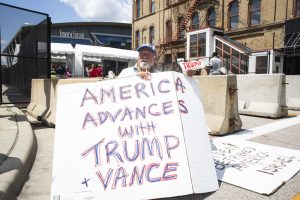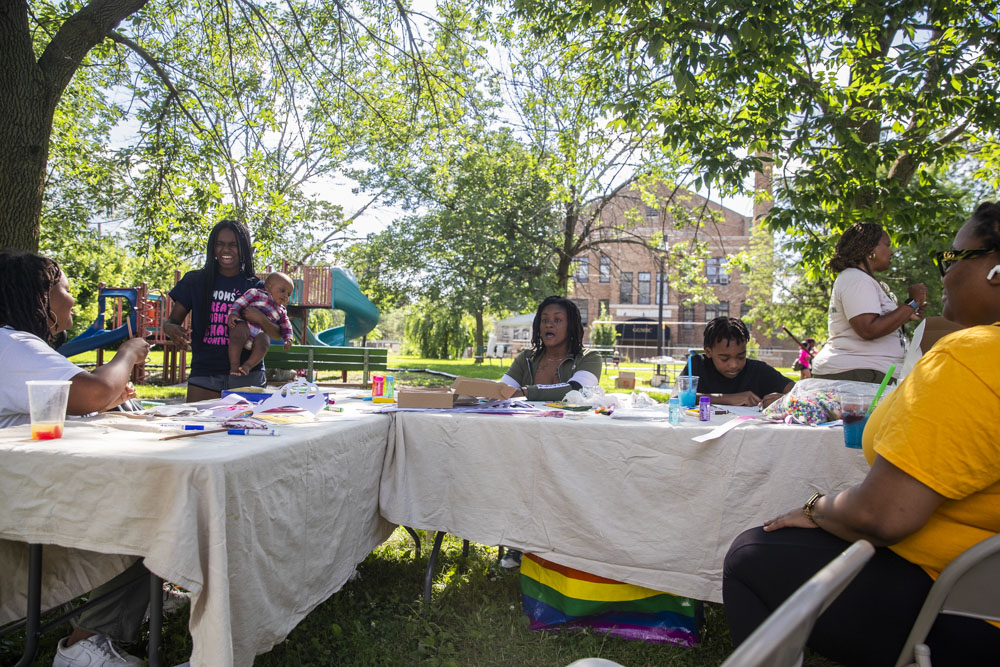MILWAUKEE — Sequestered to opposite ends of the heavily guarded inner perimeter of the Republican National Convention, two designated demonstration zones were sparsely used on the third day of the convention.
Leading up to the convention, protests were heavily anticipated, with over 140 requests for permits to protest or march submitted to the City of Milwaukee, and an anticipated 5,000 protesters and demonstrators. Three days into the convention, the demonstrations remain minimal after a large parade protest on Monday.
The U.S. Secret Service and the City of Milwaukee designated security and protest zones in June, and the city designated a route for all parades and marches. These restrictions were presented as a solution to maintain safety; however, demonstrators argue they dampen their message.
U.S District Judge Brett Ludwig ruled in favor of the regulations, determining the two designated protest zones and parade route as adequate and not in violation of the First Amendment.
Demonstration organizers and others hoping to participate were disillusioned by the far-away locations designated for free speech. Some ventured closer to the barricades, standing outside of two of the main security check points — others opted to host events away from downtown Milwaukee.
Over a dozen demonstrators with Truth Pharm gathered in the designated protest zone at Zeidler Union Square, staking tombstone shaped signs with the names, pictures, and stories of the loved ones they had lost to drug overdose.

Alexis Pleus, founder and executive director of Truth Pharm, was displeased with the turnout and disheartened about the demonstration zone being so far away from the convention.
Pleus said her organization and other demonstrators should be able to spread their message, especially because her organization’s message is apolitical.
“They are not listening to families, they are not hearing our voices, they seem to have no interest in hearing from directly impacted people,” Pleus said. “They shove us in a corner where they don’t have to listen to us.”
Pleus said communication from the City of Milwaukee regarding her demonstration was confusing, and she was angered that the zone was placed in an area without an audience.
The group painted tombstones outside of the entrance to Fiserv Forum on Tuesday, and Pleus questioned why the group’s demonstration scheduled with the city wasn’t at that location.
“Why were they so afraid to put us there?” Pleus said. “Instead they shoved us out here, so we will probably take our message down there where it can be heard, and hopefully they don’t they don’t think that they can infringe upon my First Amendment rights.”
Individuals boost their messages
Despite the designated demonstration zones, individuals staged various demonstrations outside of the entrances to Fiserv Forum and Baird Center.
Bob Kunst, 82, of Miami Beach, Florida, sat in a lawn chair at the

security checkpoint outside of Fiserv Forum, holding a handmade sign reading “America advances with Trump and Vance.”
Kunst, a registered Democrat, said he plans to vote for former President Donald Trump. He is drawn to Trump’s border policy and disapproves of President Joe Biden’s policy regarding the Israel-Hamas conflict.
Brendan McNamara, a street preacher from North Carolina, stood outside of the entrance to Baird Center, passing around handouts referencing the Bible to passersby.
McNamara was expecting a larger crowd with more opposition to Trump and the Republican party and said he was shocked by the small gathering of people.
“It’s just a lot less [people] than I thought,” he said. “It’s just a weird, slow trickle of people.”
‘Joyful rebellion’
Avoiding the cluster of downtown Milwaukee, a network of local progressive organizations, nonprofits, and small businesses hosted a collection of events and activities aimed to celebrate the city and rebel against the Republican National Convention.
Dubbed the Great Milwaukee Block Party, the week-long celebration features 35 locations hosting 45 events throughout the Milwaukee community as “acts of joyful rebellion during the RNC.”
In coordination with the Milwaukee Childcare Collective and Mighty Small Moments, the block party hosted a childrens’ clothes swap and book giveaway in Lindsay Heights Wednesday — 2.2 miles away from the convention.
Dozens of Milwaukee locals attended the event, participating in the clothes swap, rifling through piles of donated books, and playing games.

Milwaukee resident Amy Horst, 55, organized the event and was thrilled with the turnout, considering they had to relocate because of a fatal police shooting at the initial location, King Park, on Tuesday.
Horst said it would be disrespectful and inappropriate to hold their festive event at the location of the shooting, so with the help of City of Milwaukee employee and Mighty Small Moments member, Dea Wright, the event was moved.
Horst said they were thrilled with the turnout and how the community embraced the event — a group who lives near the park brought over trays of free grilled hotdogs and hamburgers, a nearby business offered the use of their restrooms, and kids ran happily through the park with painted faces.
“We wanted to make a statement that that event is not what Milwaukee is, Milwaukee is out here in the neighborhoods, people coming together to share space and time and ideas and rebellious joy,” Horst said. “They can have downtown. They will come and go, and it’s not relevant to the life of our city.”
Rae Chappelle, an organizer of the Great Milwaukee Block Party, said the events engage more
community members in more parts of the city than typical protests, which are often inaccessible.
“We’re not going to be safe through electoral politics. We need to build relationships with our most immediate, local community,” Chappelle said. “Our elected officials aren’t where change happens. Change happens interpersonally and individually. We’re hoping that hosting events brings the community closer together so that we are building trust with one another so that we can keep one another safe.”
Tyrane Graham, member of Mighty Small Moments, said the event is an uplifting response to the Republican presence in Milwaukee and is doing great things for the community.
“It’s really positive and also maybe it shows what we need to do in politics, just having this joyous rebellion,” Graham said. “It’s very positive compared to … what a lot of different reactions have been.”
Graham said the protests and demonstrations occurring in downtown Milwaukee, such as the Coalition to March on the RNC 2024, are not comparable to the block party.
“What’s happening here is targeting the more community part of it, but I feel like in the same breath, you also need people in the fight to be going out there and marching and protesting to show that, ‘Hey, we’re upset about this, and we’re just not going to be happy,” Graham said.
Stephanie Roades, an organizer of the block party, didn’t want Milwaukee portrayed in a negative light, so she decided to create the community events focusing on fostering connections in joyful spaces.
Roades supports direct action protest and said the protests, demonstrations, and block party are all part of the “nervous system” of organizing, but each branch is different than the other.
Roades said the block party may have a long-lasting effect, spreading to different cities and inspiring others to protest in different, productive, community-minded ways.



